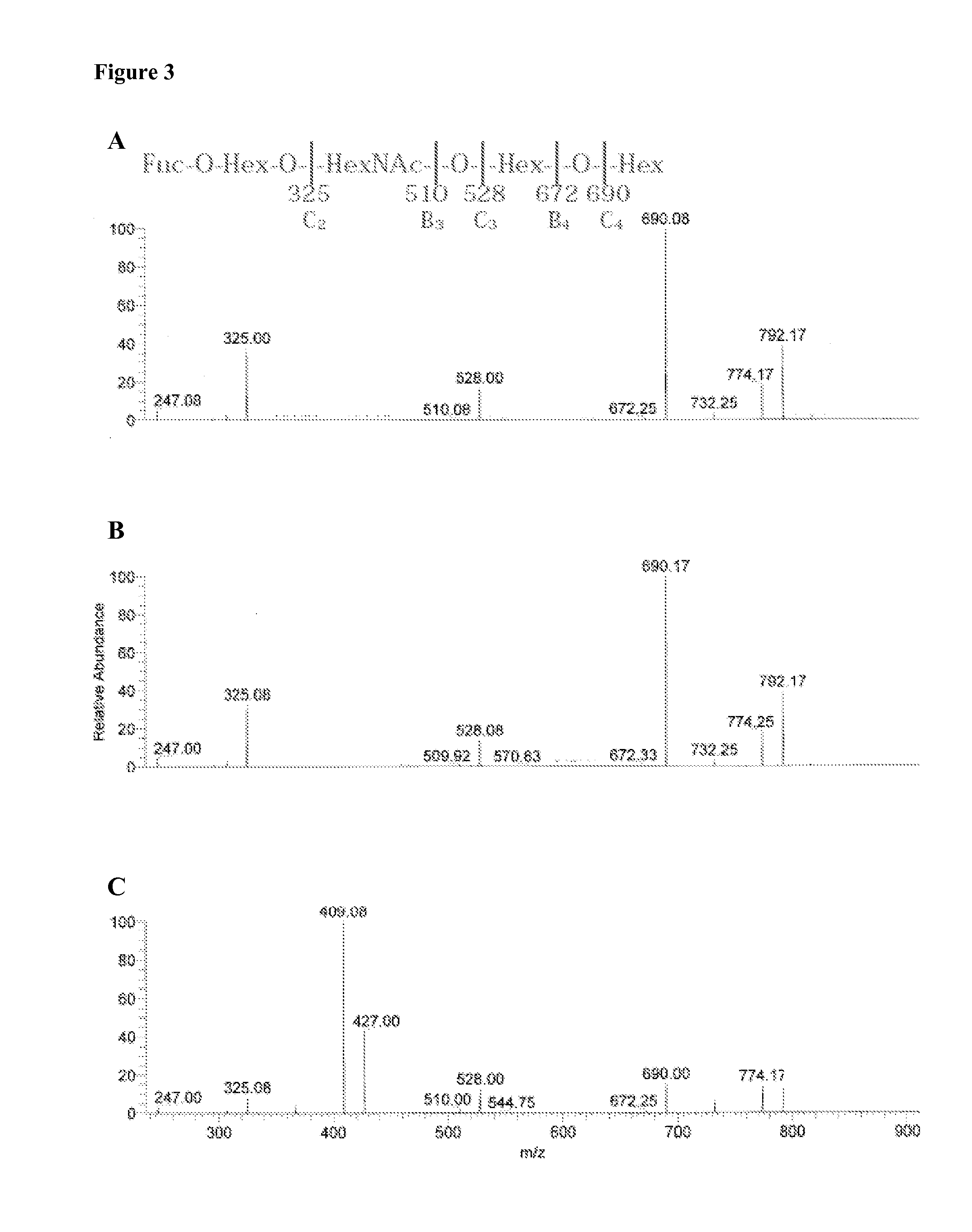Inhibitors of f18+ e coli binding
a technology of e coli and inhibitors, which is applied in the production of saccharides, peptides, medical preparations, etc., can solve the problems of pig industry substantial economic losses, take several years, and decades to establish such a population
- Summary
- Abstract
- Description
- Claims
- Application Information
AI Technical Summary
Benefits of technology
Problems solved by technology
Method used
Image
Examples
example 1
In vitro Villous Adhesion Assay
[0186]The nature of the F18R on porcine small intestinal villous enterocytes was investigated using an in vitro villous adhesion inhibition assay (Cox, E., Houvenaghel, A., 1993. Vet. Microbiol. 34(1),7-18; Verdonck, F., Cox, E., van Gog, K., Van der Stede, Y., Duchateau, L., Deprez, P., Goddeeris, B. M., 2002. Vaccine 20(23-24), 2995-3004). Briefly, a 20 cm intestinal segment was collected from the mid jejunum of a euthanized pig, rinsed three times with ice cold PBS, and fixed with Krebs-Henseleit buffer (160 mM, pH 7.4) containing 1% (v / v) formaldehyde for 30 min at 4° C. Thereafter, the villi were gently scraped from the mucosae with a glass slide and stored in Krebs-Henseleit buffer at 4° C. Treatment of villi with acetone, methanol, 1% Triton® X-100, 10 mM NaIO4 in 0.2M sodium acetate, pH 4.5, or 0.2M sodium acetate, pH 4.5, without NaIO4, respectively, was performed at room temperature on a rotating wheel in a volume of 500 μl during 1 h. Next, ...
example 2
Bacterial Strains, Culture and Labelling
[0187]The verotoxigenic F18 positive E. coli reference strain 107 / 86 (serotype O139:K12:H1, F18ab+, SLT-IIv+) (Bertschinger H U, Bachmann M, Mettler C, Pospischil A, Schraner E M, Stamm M, Sydler T, Wild P, 1990. Vet Microbiol. 25(2-3):267-81), and the enterotoxigenic F4ac positive E. coli reference strain GIS 26 (serotype O149:K91:F4ac, LT+, STa+, STb+), were cultured on BHI agar plates (Oxoid, Basingstoke, Hampshire, England) at 37° C. for 18 h. Subsequently, the bacteria were harvested by centrifugation and resuspended in phosphate-buffered saline (PBS, pH 7.3). The concentration of bacteria in the suspension was determined by measuring the optical density at 660 nm (OD660). An OD of 1 equals 109 bacteria per ml, as determined by counting colony forming units.
[0188]Recombinant E. coli strains expressing whole F18 fimbriae (HB101(pIH120), or F18 fimbriae with deletion of the FedF adhesive subunit (HB101(pIH126)) (Imberechts et al., 1992; 199...
example 3
Reference Glycosphingolipids
[0189]Total acid and non-acid glycosphingolipid fractions were prepared as described by Karlsson (Karlsson K-A, 1987. Meth. Enzymol. 138:212-220). Individual glycosphingolipids were obtained by repeated chromatography on silicic acid columns and by HPLC, and identified by mass spectrometry (Samuelsson et al., 1990) and proton NMR spectroscopy (Koerner, T. A. W. Jr., J. H. Prestegard, P. C. Demou, and R. K. Yu. 1983. Biochemistry 22:2676-2687).
PUM
| Property | Measurement | Unit |
|---|---|---|
| diameter | aaaaa | aaaaa |
| diameter | aaaaa | aaaaa |
| villous adhesion test | aaaaa | aaaaa |
Abstract
Description
Claims
Application Information
 Login to View More
Login to View More - R&D
- Intellectual Property
- Life Sciences
- Materials
- Tech Scout
- Unparalleled Data Quality
- Higher Quality Content
- 60% Fewer Hallucinations
Browse by: Latest US Patents, China's latest patents, Technical Efficacy Thesaurus, Application Domain, Technology Topic, Popular Technical Reports.
© 2025 PatSnap. All rights reserved.Legal|Privacy policy|Modern Slavery Act Transparency Statement|Sitemap|About US| Contact US: help@patsnap.com



